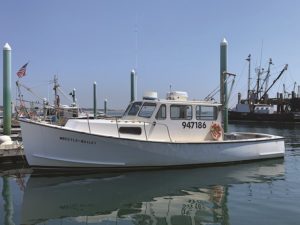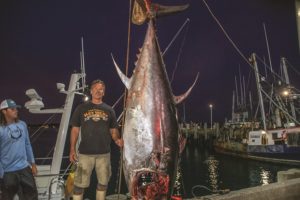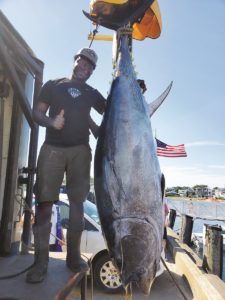PROVINCETOWN — On a calm, sunny day, the word was out among fishermen: big schools of Atlantic bluefin tuna were active and feeding just a few miles off the backside beach. But on a late July day perfect for fishing, many of the commercial boats that go after tuna remained tied up at the pier.
“You see that boat over there, the one that’s not going anywhere?” said Jim Bailey. “That’s mine.”
He was pointing to his boat, the Beetle Bailey, docked at MacMillan Pier. “I’m not even starting the boat, it’s so bad.”

With worldwide restaurant closures and fewer people eating out because of Covid-19, the demand for the Atlantic bluefin — 70 to 80 percent of which is consumed at restaurants and sushi bars — has dropped precipitously. This is keeping a lot of the Cape’s commercial fishermen off the water during a critical part of their season.
Bluefin tuna are especially prized for their high fat content. In past years, a fisherman like Bailey could catch one, call up a number of dealers while still on the boat, and have a truck at the pier ready to buy his fish when he came in.
This year, to prevent an oversupply of fish during this unusually tight market, seafood dealers have been purchasing tuna only from harpoon boats, which are few in number. Last season approximately 900 commercial vessels sold at least one bluefin tuna on the East Coast; only around 20 of them were harpoon boats.
Harpooners, standing perched above the water with a long pole in hand, have the ability to throw at the largest fish and kill it instantly. The largest fish command higher prices and offer more consistent quality for buyers.
“The challenge we need to solve is, how do we, in a fair and legal way, limit the supply to match the current demand?” said Jared Auerbach, CEO of Boston-based Red’s Best, one of the largest seafood dealers in the country.
On Sunday, he and other dealers began to buy limited amounts from rod-and-reel fishermen, too, but there’s still uncertainty over what will happen to the price of tuna as the market is opened to a larger category of fishermen.
“We are reluctant to open the floodgates,” Auerbach said.
Down on the Tuna Ranch
Even before the challenges of Covid-19, the tuna fishery, which has a deep history on the Outer Cape, was struggling to adapt to an increasingly competitive global market.
Buyers in Japan, who used to clamor for tuna caught out of Provincetown, are now more often buying the thousands of tuna caught in massive purse seining operations, in which boats net huge schools of bluefin tuna all at once. In the 1990s, the purse seiners began developing “tuna ranches,” keeping juvenile tuna in captivity in waters from Mexico to the Mediterranean to fatten them for as long as two years — until they are valuable enough to be sold for top dollar in Japan.
“The development of ranching for tuna was a major leap forward in the business efficiency side of tuna fishing,” said Grantly Galland, an advocate for regional fisheries management with the Pew Charitable Trusts. “But it also created a serious new threat to conservation and management efforts.”
In 2016, purse seiners — mostly French, Spanish, and Japanese — caught and sold 11,361 metric tons of Atlantic bluefin tuna. That’s almost 15 times as much tuna as was caught by fishermen on the East Coast.
Meanwhile, starting in 2017, a decision by the International Commission for the Conservation of Atlantic Tunas (ICCAT) to incrementally increase fishing quotas worldwide helped to saturate a market already confronting limited demand.
Provincetown’s tuna fishermen look back wistfully to the days when higher Japanese demand meant a better payday. Sitting on MacMillan Pier, James Meades, Captain of the Joe Scully II, remembered a time when dealers waited on the pier for fish.
“You see that lift over there?” asked Meades. “There used to be a guy from Japan who’d come down every summer to grade your fish right off the boat.”
Fishermen would watch as buyers inspected the fish’s fat content, hoping to receive a grade that would pay them top dollar. The biggest, fattest fish could sell for $20 to $30 dollars a pound, or upwards of $10,000.
Now, if fishermen can find a dealer, they might get $4 to $6 per pound.
Adapting to this competitive global market, seafood dealers and fishermen are now looking to an emerging domestic market for tuna. But it’s not easy competing in a market that still imports most of the bluefin eaten in the U.S. at a cheaper price from Japan, Spain, and Mexico.
The Wicked Tuna Effect

Weekend warriors are another problem that has arisen in recent years for commercial fishermen. Landing a giant bluefin has become a phenomenon among recreational fishermen in the U.S., and because a commercial license to sell tuna costs only $20, fishermen who rely on tuna for their livelihoods are struggling to deal with a growing body of competitors.
Fishermen call it the “Wicked Tuna Effect,” after the popular TV show.
“The problem is that we’ve had this migration of people into the commercial industry that catch a giant bluefin, take a picture for their Facebook, and sell it to score a few bucks,” said David Schalit, President of the Atlantic Bluefin Tuna Association (ABTA).
Sustainability? It Depends
Shaping the domestic market is a heated debate over whether the Atlantic bluefin tuna is a sustainable option for consumers.
Those in the industry have been encouraged by the success of a 20-year-long rebuilding effort implemented by ICCAT. One result: the Monterey Bay Seafood Watch recently reclassified the Atlantic bluefin as “yellow,” meaning “a good alternative.”
But results of the most recent ICAAT bluefin tuna stock assessment, which is conducted every three years, were released on July 28, and show that increased quotas from 2017 to 2020, implemented after the rebuilding program ended, have already depleted the stock, according to PEW’s Galland.
Many Cape Cod fishermen believe that the stock is healthy, citing their own observations on the water. But a hard-to-detect issue, according to Galland, is that many of the fish seen here are coming from the Mediterranean to feed — they’re not actually the Western Atlantic stock that migrate here from Mexico.
According to Galland, the latest assessment models conclude that the Western population is now just 13 percent of the 1950 level.

David Schalit at the ABTA counters that consumers should still feel good about supporting the local tuna fishery. According to Schalit, understanding where and how the tuna you want to eat was caught is key to making the right decision.
What consumers need to know, Schalit said, is that most tuna available in the U.S. is imported. In 2019, the U.S. imported $53 million worth of fresh Pacific and Atlantic bluefin tuna, compared to $5 million worth of exports.
“This is the only known artisanal fishery in the United States and that is something that we should be proud of,” Schalit said. When you see bluefin tuna on the menu, he added, you should ask where it came from and how it was caught.
Alex Hay, owner of Wellfleet Shellfish Company agreed. “What is more sustainable,” he asked, “than eating a highly quota-monitored species that is caught locally, one fish at a time?”



